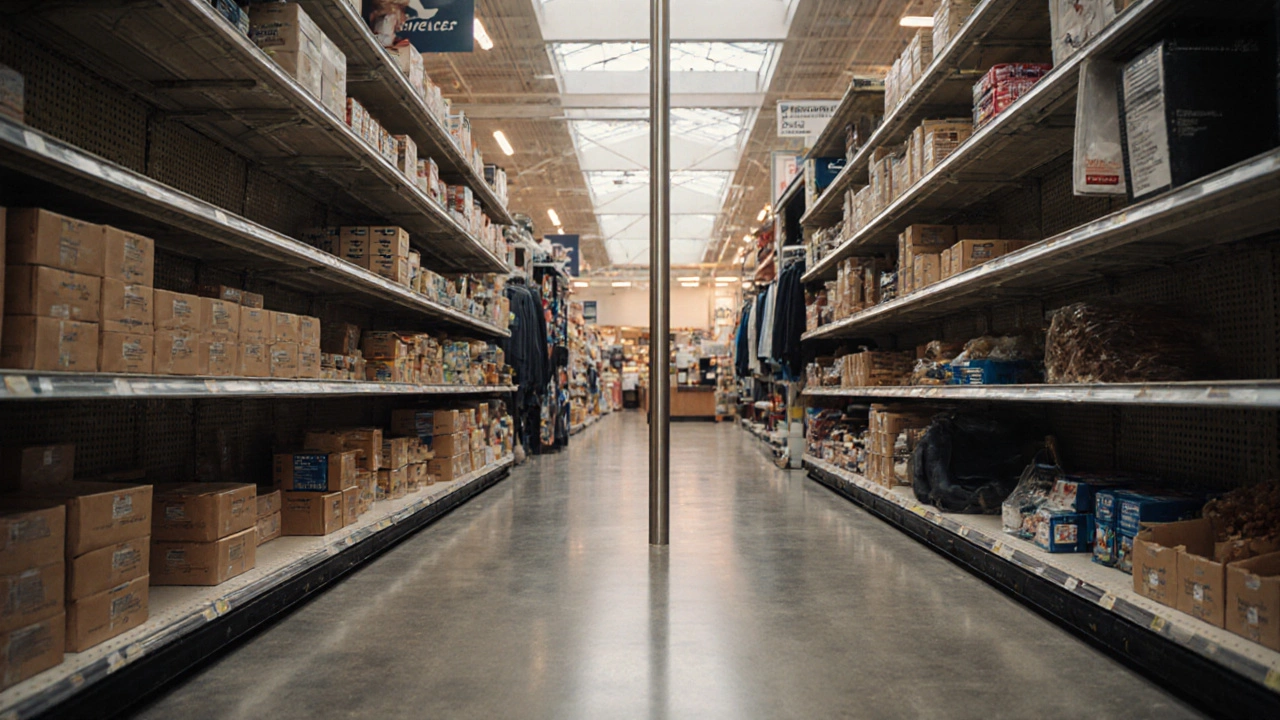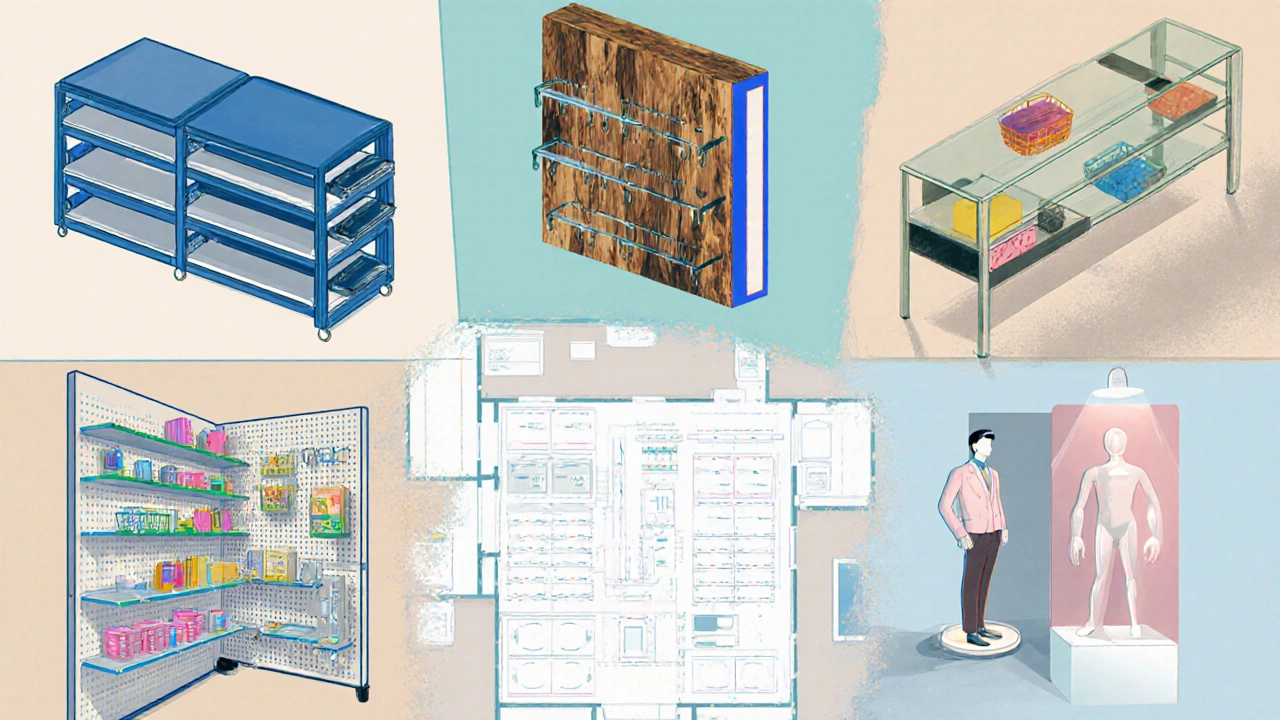Store Shelving Terminology: What It's Called & Types

Retail Shelving Selector
Select Your Needs
Recommended Shelving Type
Recommended Shelving Type
Why this type works for you
Cost Estimate
Select your needs to find your perfect shelving match
When you walk down an aisle and see products neatly lined up, you’re looking at store shelving. But have you ever wondered what the industry calls these fixtures? Knowing the right terms helps you speak the language of suppliers, plan layouts, and avoid costly misunderstandings.
Understanding Store Shelving
Store shelving is a set of horizontal surfaces supported by frames or walls, designed to display merchandise in a retail environment. It’s the backbone of any shopping experience, guiding customers and influencing buying decisions.
The broader category is retail shelving which includes all fixture types used in shops, from freestanding units to wall‑mounted systems. While the two phrases are often used interchangeably, “store shelving” tends to refer specifically to the shelf surfaces themselves, whereas “retail shelving” covers the whole fixture ecosystem.
Retailers rely on a shared vocabulary to discuss placement, capacity, and aesthetics. When you ask a vendor for “gondola units,” you’ll get a different product than if you request “wall shelving.” Knowing these names saves time and money.
Common Types of Store Shelving
Below are the most frequently encountered shelving types. Each serves a unique purpose and varies in material, height, and adjustability.
| Type | Typical Height | Material | Best Use |
|---|---|---|---|
| Gondola shelving | 5‑7 ft | Steel, melamine | Supermarkets, apparel aisles |
| Wall shelving | 2‑6 ft | Wood, metal, glass | Small boutiques, accessories |
| End cap | 3‑4 ft | Metal, acrylic | Promotional displays near aisle ends |
| Pegboard | Varies | Steel, wood | Hardware, tools, small accessories |
| Bin shelving | 3‑5 ft | Plastic, metal | Impulse items, toys, snacks |
| Display fixture | Varies | Custom finishes | Seasonal merch, high‑margin products |
These six families cover more than 80 % of what you’ll see on the shop floor. Let’s unpack the most popular ones.
Gondola Shelving
Also called “double‑faced” shelving, gondolas consist of a vertical central spine with two rows of shelves extending outward. They’re modular, so you can add or remove sections as inventory changes. Because they’re freestanding, they work well in wide aisles where you need 360‑degree visibility.
Key attributes:
- Adjustable shelf heights (typically every 2‑3 inches).
- Heavy‑duty steel frames support large boxes.
- Optional accessories like bolsters, weight‑rated brackets, and built‑in lighting.
Wall Shelving
Wall‑mounted shelves free up floor space and create a clean, minimalist look. They’re common in boutique clothing stores where visual appeal outweighs bulk storage. Materials range from reclaimed wood for a rustic vibe to sleek metal with glass tops for a modern feel.
Consider the load rating-most residential‑grade wall shelving tops out at 50 lb per shelf, while commercial‑grade options can hold 200 lb or more.
End Caps
These are the short, often eye‑catching displays placed at the ends of aisles. Because shoppers see them from both directions, they’re prime real estate for promotions, seasonal items, or brand‑specific showcases. End caps can be simple flat panels or fully assembled shelving units with integrated lighting.
Pegboards
Pegboards are vertical panels perforated with evenly spaced holes. By inserting hooks, bins, or baskets, you create a highly flexible system ideal for small, oddly‑shaped items like hardware, cosmetics, or electronics accessories. They’re cheap, easy to re‑configure, and work well in service‑oriented retail spaces.
Bin Shelving
Bin shelving consists of shallow trays or baskets set on adjustable shelves. The design encourages quick grabs, making it perfect for impulse buys-candy, small toys, or travel accessories. Plastic bins are lightweight and easy to clean; metal bins add durability for heavier stock.
Display Fixtures
“Display fixture” is a catch‑all term for custom‑built units that don’t fit the standard categories above. Think of a mannequin‑mounted rack for apparel, a countertop showcase for cosmetics, or a freestanding island for electronics. Because they’re bespoke, they often come with a higher price tag but can dramatically boost brand perception.

Choosing the Right Shelving for Your Retail Space
Picking the ideal shelving isn’t just about looks; it’s a strategic decision that affects traffic flow, inventory turnover, and operating costs.
- Assess your product dimensions. Bulky items (e.g., bags of flour) need deeper, sturdier shelves like gondola units, while small accessories thrive on pegboards or bin shelving.
- Map customer pathways. Use heat‑map data or simple observation to see where shoppers linger. Place high‑margin items at eye level on end caps or display fixtures to maximize exposure.
- Consider adjustability. Seasonal changes often require height adjustments. Systems with T‑slot brackets or pin‑based rails let you re‑configure without new hardware. \n
- Factor in load capacity. Heavy inventory (e.g., canned goods) demands steel‑frame gondolas with reinforced brackets. Light items can use wall shelving with lighter gauges.
- Budget for durability. High‑traffic areas benefit from powder‑coated steel; aesthetic‑focused zones may justify pricier wood finishes.
When in doubt, start with a modular gondola system. Its flexibility lets you test layouts, add accessories, and scale as your product mix evolves.
Installation and Maintenance Tips
Even the best‑designed shelving can underperform if installed incorrectly.
- Level the floor. Use a laser level to ensure each unit sits flat. Uneven floors cause shelves to sag and can lead to product damage.
- Secure wall anchors. For wall shelving, select anchors rated for the anticipated load. Metal studs require toggle bolts, while wooden studs need lag screws.
- Follow manufacturer torque specs. Over‑tightening bolts can strip threads, while under‑tightening creates wobble.
- Apply protective finishes. If you choose wood, seal it with a low‑VOC varnish to resist spills and scratches.
- Schedule quarterly checks. Look for loose brackets, worn brackets, or dents that could become safety hazards.
Proactive maintenance extends the life of your fixtures, saves on replacement costs, and keeps the shopping environment safe.
Cost Considerations and Budgeting
Pricing varies widely based on material, finish, and customization.
- Basic steel gondola: $45‑$80 per linear foot.
- Wooden wall shelving: $25‑$60 per shelf, depending on finish.
- Custom display fixture: $300‑$2,000+ per unit.
- Installation labor: $50‑$100 per hour, plus any electrical work for lighting.
To keep costs in check, order in bulk and ask suppliers about “stock‑size” options that fit standard dimensions. Custom work should be reserved for flagship locations where the visual impact justifies the expense.
Frequently Asked Questions
What is the difference between gondola shelving and wall shelving?
Gondola shelving is a free‑standing, double‑faced unit that creates aisles, while wall shelving is mounted directly to a wall, saving floor space but offering fewer viewing angles.
Can I use the same shelving for both retail and warehouse storage?
You can, but retail shelves prioritize aesthetics and customer reach, whereas warehouse shelves focus on load capacity and durability. Mixing them may compromise either appearance or strength.
How often should I re‑configure my store shelving?
Seasonal changes or major product line updates typically prompt a re‑layout every 3‑6 months. Adjustable systems make this quicker and cheaper.
Are there eco‑friendly options for store shelving?
Yes. Recycled steel, reclaimed wood, and bamboo are popular sustainable choices. Look for certifications like FSC for wood or recycled content percentages for metal.
What safety standards apply to retail shelving?
In the U.S., the Consumer Product Safety Commission (CPSC) guidelines and OSHA regulations govern load limits, anchoring requirements, and edge protection for public spaces.
Understanding the terminology behind store fixtures empowers you to plan smarter, negotiate better with vendors, and keep your shop looking sharp. Whether you’re a small boutique owner or a large‑scale retailer, the right shelving language is the first step toward a well‑organized, profitable floor.